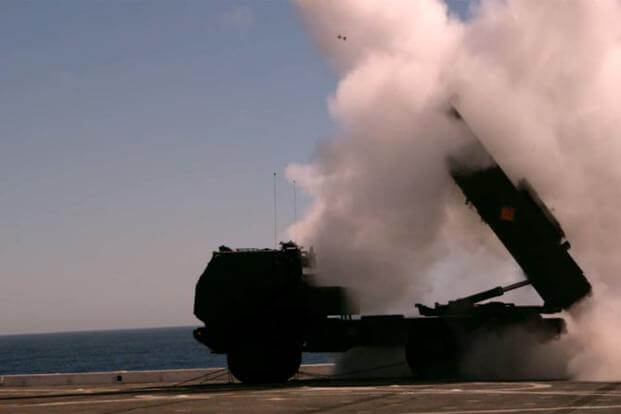ANNAPOLIS, Md. -- The amphibious transport dock USS Anchorage became the base for a High Mobility Artillery Rocket System rocket launch this week when Marines obliterated a land-based target from the sea during a training exercise in the Pacific.
The test took place Oct. 22 with the kickoff of Operation Dawn Blitz, a major Navy and Marine Corps annual exercise.
The HIMARS took out an unidentified land-based target from a distance of 70 kilometers, or roughly 43 miles, using a Guided Multiple Launch Rocket System Unitary, or GMLRS-U, according to a Navy news release.
That represents the maximum range for the GMLRS-U, which hits targets at a speed of Mach 2.5. The 200-pound warhead uses GPS for accurate target destruction and is designed to reduce ammunition expenditure and collateral damage.
"We had two training objectives for today's shoot," said Army Maj. Adam Ropelewski, lead planner for sea-based expeditionary fires at I Marine Expeditionary Force, in a statement. "The first training objective was demonstrating this capability and, second, we wanted to have good effects on the target. We achieved both objectives."
Marine Commandant Gen. Robert Neller has advocated for the Corps to make greater use of HIMARS in an amphibious context.
"We're looking at munitions and capabilities that can be fired out of existing things," he told reporters during a defense conference in December.
"I would love to have an anti-ship cruise missile I could shoot out of a HIMARS launcher," Neller said. "So if the Marines, for example, were to go to seize and secure an advance expeditionary amphibious base and the adversary had ships -- rather than attack them with an airplane, I'd like to be able to have some way to defend from the shore."
HIMARS is a vehicle-mounted light rocket launcher system that both the Marine Corps and Army use. Primarily used from land, it can be carried in a C-130 Hercules aircraft and can fire M270 artillery rockets and anti-aircraft missiles.
Lt. Gen. Brian Beaudreault, Marine Corps deputy commandant for plans, policies and operations, described the effort as supporting the service's new Littoral Operations in a Contested Environment concept, which has the Navy and Corps operating in closer concert to become more lethal from the sea.
"Whether that's shooting rocket artillery from an amphibious platform or an alternative platform is something that we're looking at and refining," he said. "What we have may fit the bill, or it might be an adjustment to what we currently have."
Major sea-based exercises give the Navy and Marine Corps the chance to experiment with new ways to employ weapons and equipment. With biennial North Carolina-based exercise Bold Alligator having been significantly scaled back in the wake of major hurricane relief efforts, eyes are on Dawn Blitz to prove out new concepts, Beaudreault said.
"What we didn't learn on the East Coast, we can learn on the West Coast," he said.
In addition to proving that HIMARS can be shot from an amphib to take out a land-based target, the proof of concept test demonstrated the ability of the Marine Corps and Navy to work together, Ropelewski said.
"What we demonstrated not only was its capability, but we further demonstrated capabilities from the blue-green team," he said. "They performed very well and were able to come together and work hard to make the mission successful."
-- Hope Hodge Seck can be reached at hope.seck@military.com. Follow her on Twitter at @HopeSeck.










